What Does An Average Brake Light Repair Cost
PDF: Nosotros made a fancy PDF of this post for printing and offline viewing. Purchase it here. (Or see a preview.)
Note: The reason this postal service took three weeks to finish is that as I dug into research on Artificial Intelligence, I could not believe what I was reading. It hit me pretty quickly that what'southward happening in the globe of AI is non only an important topic, merely by far THE most important topic for our hereafter. So I wanted to acquire as much as I could most information technology, and one time I did that, I wanted to brand certain I wrote a post that really explained this whole state of affairs and why it matters so much. Not shockingly, that became outrageously long, so I broke it into two parts. This is Part ane—Role 2 is here.
_______________
Nosotros are on the border of alter comparable to the rise of human being life on World. — Vernor Vinge
What does information technology experience similar to stand up here?
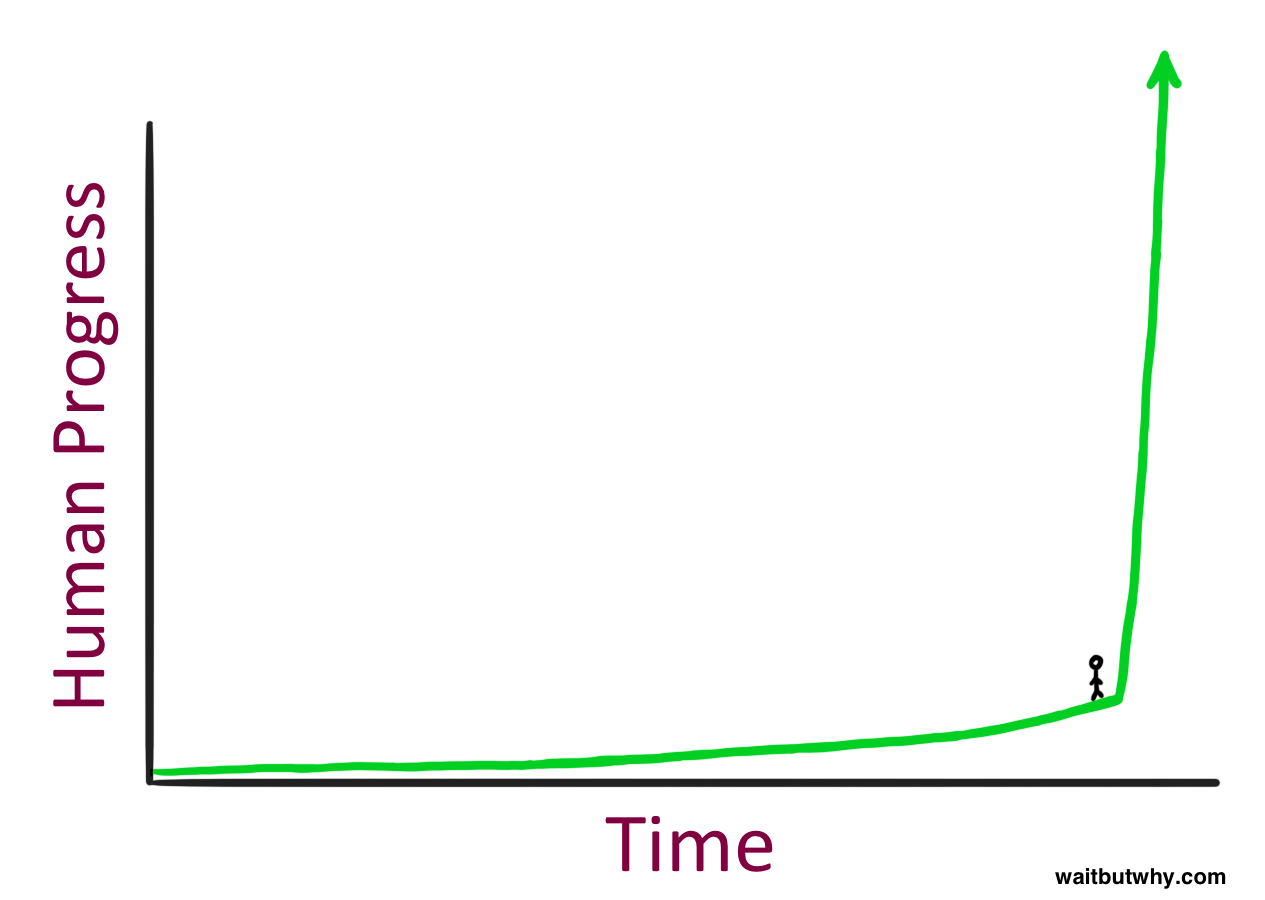
It seems like a pretty intense identify to be standing—but then you have to retrieve something nigh what information technology's like to stand up on a time graph: you can't see what'south to your correct. And then here'due south how it really feels to stand there:

Which probably feels pretty normal…
_______________
The Far Time to come—Coming Before long
Imagine taking a time auto back to 1750—a time when the world was in a permanent power outage, long-altitude communication meant either yelling loudly or firing a cannon in the air, and all transportation ran on hay. When you get in that location, you retrieve a dude, bring him to 2022, then walk him effectually and watch him react to everything. Information technology's impossible for us to understand what it would be like for him to come across shiny capsules racing by on a highway, talk to people who had been on the other side of the ocean earlier in the day, lookout man sports that were being played 1,000 miles away, hear a musical operation that happened 50 years ago, and play with my magical wizard rectangle that he could use to capture a real-life image or tape a living moment, generate a map with a paranormal moving blue dot that shows him where he is, wait at someone's face and chat with them even though they're on the other side of the country, and worlds of other inconceivable sorcery. This is all before you bear witness him the internet or explain things like the International Space Station, the Large Hadron Collider, nuclear weapons, or general relativity.
This experience for him wouldn't be surprising or shocking or even heed-blowing—those words aren't big enough. He might actually die.
Simply here'due south the interesting thing—if he and so went back to 1750 and got jealous that nosotros got to see his reaction and decided he wanted to try the same thing, he'd have the fourth dimension car and go back the same distance, become someone from effectually the year 1500, bring him to 1750, and testify him everything. And the 1500 guy would be shocked by a lot of things—just he wouldn't dice. It would be far less of an insane experience for him, because while 1500 and 1750 were very different, they were much less different than 1750 to 2022. The 1500 guy would acquire some heed-bending shit virtually space and physics, he'd be impressed with how committed Europe turned out to exist with that new imperialism fad, and he'd have to do some major revisions of his world map conception. Just watching everyday life go past in 1750—transportation, communication, etc.—definitely wouldn't make him die.
No, in order for the 1750 guy to have as much fun as we had with him, he'd have to go much farther back—maybe all the way back to most 12,000 BC, before the Commencement Agronomical Revolution gave rise to the first cities and to the concept of civilization. If someone from a purely hunter-gatherer world—from a fourth dimension when humans were, more than or less, simply some other animal species—saw the vast man empires of 1750 with their towering churches, their body of water-crossing ships, their concept of existence "inside," and their enormous mountain of collective, accumulated human knowledge and discovery—he'd likely die.
And then what if, afterwards dying, he got jealous and wanted to do the aforementioned matter. If he went back 12,000 years to 24,000 BC and got a guy and brought him to 12,000 BC, he'd show the guy everything and the guy would be like, "Okay what's your signal who cares." For the 12,000 BC guy to take the same fun, he'd have to get back over 100,000 years and get someone he could show fire and language to for the starting time time.
In club for someone to be transported into the hereafter and die from the level of shock they'd experience, they accept to get enough years ahead that a "dice level of progress," or a Die Progress Unit of measurement (DPU) has been achieved. And so a DPU took over 100,000 years in hunter-gatherer times, but at the post-Agricultural Revolution rate, it merely took nigh 12,000 years. The mail service-Industrial Revolution world has moved so quickly that a 1750 person just needs to go frontward a couple hundred years for a DPU to have happened.
This design—man progress moving quicker and quicker as time goes on—is what futurist Ray Kurzweil calls human history'south Constabulary of Accelerating Returns. This happens because more avant-garde societies accept the ability to progress at a faster charge per unit than less advanced societies—considering they're more avant-garde. 19th century humanity knew more and had better applied science than 15th century humanity, so information technology'due south no surprise that humanity made far more than advances in the 19th century than in the 15th century—15th century humanity was no match for 19th century humanity.11 ← open these
This works on smaller scales also. The movie Back to the Future came out in 1985, and "the by" took identify in 1955. In the moving picture, when Michael J. Fox went back to 1955, he was caught off-guard by the newness of TVs, the prices of soda, the lack of beloved for shrill electric guitar, and the variation in slang. It was a dissimilar globe, yeah—only if the picture were fabricated today and the past took identify in 1985, the picture could accept had much more fun with much bigger differences. The character would be in a time before personal computers, internet, or cell phones—today's Marty McFly, a teenager born in the tardily 90s, would exist much more out of place in 1985 than the film's Marty McFly was in 1955.
This is for the aforementioned reason we just discussed—the Law of Accelerating Returns. The average charge per unit of advancement between 1985 and 2022 was higher than the rate betwixt 1955 and 1985—because the former was a more avant-garde world—and so much more change happened in the well-nigh recent thirty years than in the prior 30.
Then—advances are getting bigger and bigger and happening more and more quickly. This suggests some pretty intense things about our future, right?
Kurzweil suggests that the progress of the entire 20th century would take been accomplished in only xx years at the charge per unit of advancement in the year 2000—in other words, by 2000, the rate of progress was five times faster than the average rate of progress during the 20th century. He believes some other 20th century's worth of progress happened between 2000 and 2022 and that another 20th century'south worth of progress will happen by 2022, in simply vii years. A couple decades later, he believes a 20th century's worth of progress volition happen multiple times in the aforementioned twelvemonth, and even after, in less than 1 month. All in all, because of the Police of Accelerating Returns, Kurzweil believes that the 21st century will attain 1,000 times the progress of the 20th century.2
If Kurzweil and others who agree with him are right, and then nosotros may be as blown away by 2030 as our 1750 guy was past 2022—i.e. the side by side DPU might only take a couple decades—and the world in 2050 might be and so vastly different than today's earth that we would barely recognize it.
This isn't science fiction. Information technology's what many scientists smarter and more knowledgeable than you or I firmly believe—and if yous look at history, information technology's what we should logically predict.
Then then why, when you lot hear me say something like "the globe 35 years from now might be totally unrecognizable," are yous thinking, "Cool….just nahhhhhhh"? Three reasons we're skeptical of outlandish forecasts of the future:
1) When it comes to history, nosotros think in directly lines. When we imagine the progress of the next thirty years, we wait back to the progress of the previous thirty as an indicator of how much will likely happen. When we think nigh the extent to which the world will change in the 21st century, we just take the 20th century progress and add information technology to the year 2000. This was the aforementioned mistake our 1750 guy made when he got someone from 1500 and expected to accident his mind as much as his own was blown going the same distance ahead. It's most intuitive for the states to think linearly, when we should be thinking exponentially. If someone is beingness more clever nigh information technology, they might predict the advances of the next xxx years not by looking at the previous 30 years, but past taking the current charge per unit of progress and judging based on that. They'd be more authentic, but all the same manner off. In order to think about the future correctly, you need to imagine things moving at a much faster rate than they're moving at present.
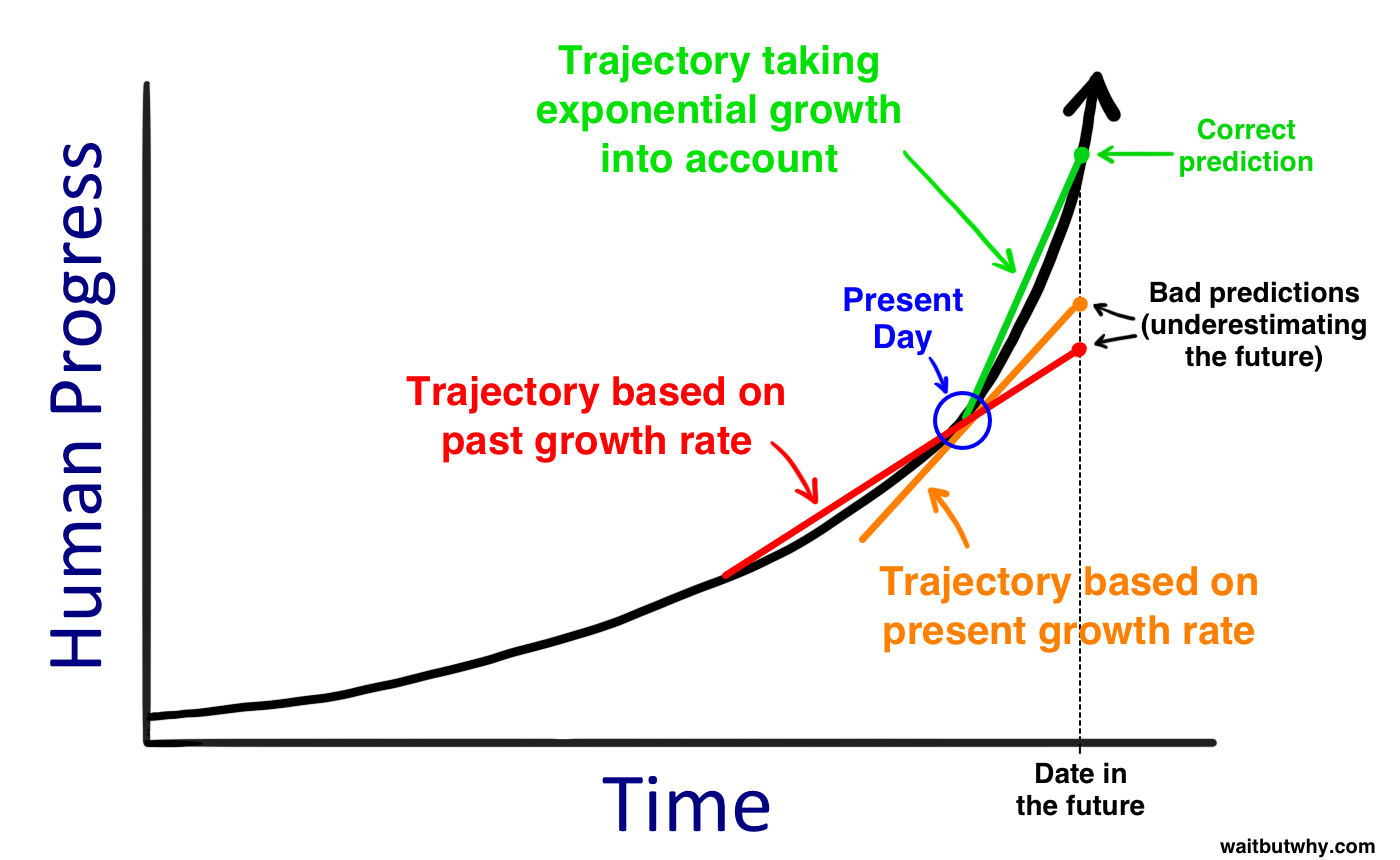
ii) The trajectory of very recent history often tells a distorted story. First, even a steep exponential curve seems linear when y'all merely wait at a tiny slice of it, the aforementioned way if y'all await at a fiddling segment of a huge circle up shut, information technology looks almost like a straight line. Second, exponential growth isn't totally smooth and uniform. Kurzweil explains that progress happens in "S-curves":
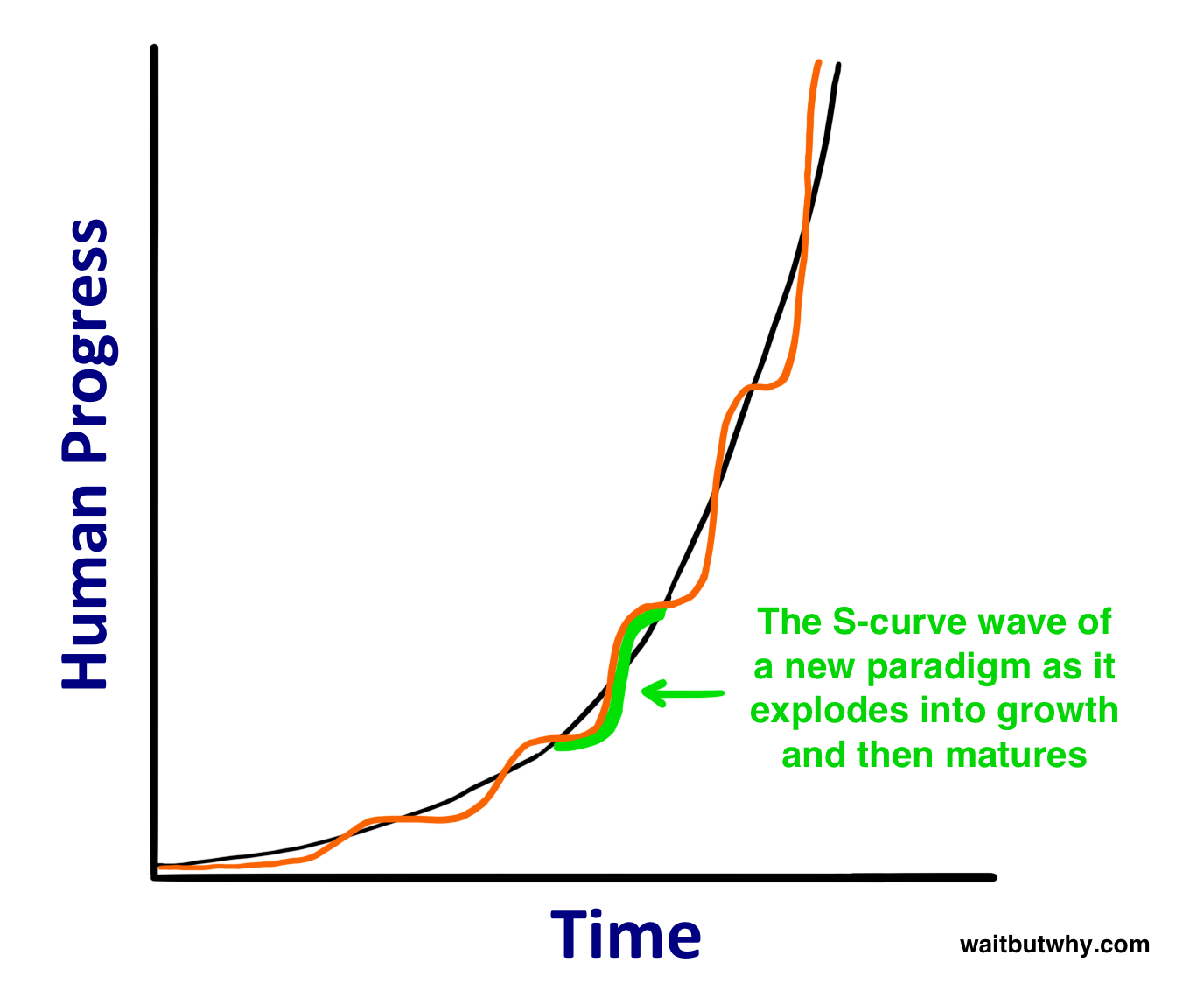
An S is created by the wave of progress when a new paradigm sweeps the world. The curve goes through three phases:
ane. Dull growth (the early on phase of exponential growth)
2. Rapid growth (the belatedly, explosive phase of exponential growth)
iii. A leveling off as the particular paradigm matures3
If y'all look only at very recent history, the role of the S-curve you're on at the moment can obscure your perception of how fast things are advancing. The chunk of fourth dimension between 1995 and 2007 saw the explosion of the cyberspace, the introduction of Microsoft, Google, and Facebook into the public consciousness, the birth of social networking, and the introduction of prison cell phones and then smart phones. That was Stage 2: the growth spurt office of the S. But 2008 to 2022 has been less groundbreaking, at to the lowest degree on the technological forepart. Someone thinking about the hereafter today might examine the last few years to approximate the current charge per unit of advancement, but that'due south missing the bigger picture. In fact, a new, huge Stage ii growth spurt might be brewing correct now.
3) Our own feel makes us stubborn old men about the future. We base our ideas about the world on our personal experience, and that experience has ingrained the rate of growth of the recent by in our heads every bit "the mode things happen." We're besides limited by our imagination, which takes our feel and uses information technology to conjure hereafter predictions—but often, what we know simply doesn't give us the tools to think accurately about the future.2 When we hear a prediction about the time to come that contradicts our experience-based notion of how things work, our instinct is that the prediction must be naive. If I tell yous, later in this post, that y'all may live to be 150, or 250, or not dice at all, your instinct will be, "That'south stupid—if in that location's one thing I know from history, information technology'south that everybody dies." And yes, no one in the past has non died. Merely no i flew airplanes before airplanes were invented either.
So while nahhhhh might feel right equally yous read this mail, it's probably actually incorrect. The fact is, if we're existence truly logical and expecting historical patterns to continue, we should conclude that much, much, much more should change in the coming decades than nosotros intuitively expect. Logic likewise suggests that if the most advanced species on a planet keeps making larger and larger leaps forward at an e'er-faster rate, at some point, they'll make a leap so great that information technology completely alters life as they know it and the perception they take of what it means to exist a man—kind of like how evolution kept making cracking leaps toward intelligence until finally information technology made such a large leap to the human that it completely contradistinct what it meant for any creature to live on planet Globe. And if you spend some time reading near what'due south going on today in science and engineering science, you start to see a lot of signs quietly hinting that life as we currently know information technology cannot withstand the leap that's coming next.
_______________
The Route to Superintelligence
What Is AI?
If you're like me, yous used to remember Bogus Intelligence was a giddy sci-fi concept, but lately yous've been hearing it mentioned by serious people, and you don't really quite become it.
There are iii reasons a lot of people are confused about the term AI:
1) We associate AI with movies. Star Wars. Terminator. 2001: A Space Odyssey. Even the Jetsons. And those are fiction, as are the robot characters. Then it makes AI sound a little fictional to united states of america.
ii) AI is a wide topic. It ranges from your phone'due south calculator to self-driving cars to something in the future that might change the world dramatically. AI refers to all of these things, which is disruptive.
3) Nosotros use AI all the fourth dimension in our daily lives, but we often don't realize it'southward AI. John McCarthy, who coined the term "Artificial Intelligence" in 1956, complained that "as soon as information technology works, no one calls it AI anymore."4 Because of this phenomenon, AI often sounds like a mythical future prediction more than than a reality. At the same time, it makes it sound like a pop concept from the by that never came to fruition. Ray Kurzweil says he hears people say that AI withered in the 1980s, which he compares to "insisting that the Net died in the dot-com bust of the early 2000s."5
So let's clear things up. Outset, stop thinking of robots. A robot is a container for AI, sometimes mimicking the human being form, sometimes not—but the AI itself is the computer inside the robot. AI is the brain, and the robot is its body—if it even has a body. For example, the software and data behind Siri is AI, the woman'due south voice we hear is a personification of that AI, and at that place's no robot involved at all.
Secondly, you've probably heard the term "singularity" or "technological singularity." This term has been used in math to draw an asymptote-like situation where normal rules no longer use. It'southward been used in physics to draw a phenomenon like an infinitely small, dense black hole or the indicate nosotros were all squished into right before the Large Bang. Once more, situations where the usual rules don't apply. In 1993, Vernor Vinge wrote a famous essay in which he applied the term to the moment in the time to come when our technology's intelligence exceeds our own—a moment for him when life as we know it will be forever inverse and normal rules will no longer utilize. Ray Kurzweil then muddled things a bit by defining the singularity as the time when the Law of Accelerating Returns has reached such an extreme pace that technological progress is happening at a seemingly-infinite pace, and after which we'll be living in a whole new world. I establish that many of today'south AI thinkers have stopped using the term, and information technology's confusing anyway, so I won't utilise it much here (even though we'll be focusing on that idea throughout).
Finally, while there are many different types or forms of AI since AI is a broad concept, the critical categories we need to remember about are based on an AI's quotient. There are three major AI quotient categories:
AI Caliber i) Artificial Narrow Intelligence (ANI): Sometimes referred to as Weak AI, Artificial Narrow Intelligence is AI that specializes in 1 area. There'due south AI that can beat the globe chess champion in chess, but that's the simply affair it does. Ask it to effigy out a improve way to store data on a difficult drive, and it'll look at y'all blankly.
AI Quotient 2) Artificial Full general Intelligence (AGI): Sometimes referred to as Strong AI, or Human being-Level AI, Artificial General Intelligence refers to a estimator that is as smart equally a human across the board—a machine that can perform any intellectual task that a human being tin. Creating AGI is a much harder task than creating ANI, and we're yet to do information technology. Professor Linda Gottfredson describes intelligence every bit "a very full general mental adequacy that, amidst other things, involves the ability to reason, plan, solve issues, call up abstractly, comprehend complex ideas, larn quickly, and learn from experience." AGI would be able to practise all of those things as easily as you can.
AI Quotient iii) Artificial Superintelligence (ASI): Oxford philosopher and leading AI thinker Nick Bostrom defines superintelligence equally "an intellect that is much smarter than the all-time homo brains in practically every field, including scientific creativity, general wisdom and social skills." Bogus Superintelligence ranges from a calculator that's but a little smarter than a homo to ane that's trillions of times smarter—across the board. ASI is the reason the topic of AI is such a spicy meatball and why the words "immortality" and "extinction" will both appear in these posts multiple times.
As of now, humans accept conquered the everyman caliber of AI—ANI—in many ways, and it's everywhere. The AI Revolution is the road from ANI, through AGI, to ASI—a route nosotros may or may not survive simply that, either way, volition modify everything.
Allow's take a close look at what the leading thinkers in the field believe this road looks similar and why this revolution might happen mode sooner than you might retrieve:
Where Nosotros Are Currently—A World Running on ANI
Bogus Narrow Intelligence is machine intelligence that equals or exceeds homo intelligence or efficiency at a specific affair. A few examples:
- Cars are total of ANI systems, from the computer that figures out when the anti-lock brakes should kick in to the computer that tunes the parameters of the fuel injection systems. Google's self-driving car, which is being tested at present, volition contain robust ANI systems that allow information technology to perceive and react to the earth effectually it.
- Your phone is a little ANI factory. When you navigate using your map app, receive tailored music recommendations from Pandora, check tomorrow'south weather condition, talk to Siri, or dozens of other everyday activities, y'all're using ANI.
- Your email spam filter is a classic type of ANI—it starts off loaded with intelligence near how to figure out what's spam and what'southward non, and so information technology learns and tailors its intelligence to you equally it gets experience with your particular preferences. The Nest Thermostat does the aforementioned thing as information technology starts to figure out your typical routine and human activity accordingly.
- You know the whole creepy thing that goes on when you search for a product on Amazon and then you lot see that every bit a "recommended for you lot" product on a different site, or when Facebook somehow knows who it makes sense for y'all to add as a friend? That'southward a network of ANI systems, working together to inform each other most who you are and what you similar so using that information to decide what to show you. Aforementioned goes for Amazon'due south "People who bought this also bought…" thing—that's an ANI system whose job information technology is to gather info from the behavior of millions of customers and synthesize that info to cleverly upsell you so you'll buy more things.
- Google Translate is another classic ANI organization—impressively expert at 1 narrow task. Voice recognition is another, and there are a bunch of apps that use those 2 ANIs as a tag team, allowing you lot to speak a sentence in one linguistic communication and accept the telephone spit out the same judgement in another.
- When your plane lands, information technology's not a human that decides which gate it should become to. But like information technology's not a homo that determined the toll of your ticket.
- The world's all-time Checkers, Chess, Scrabble, Backgammon, and Othello players are now all ANI systems.
- Google search is one large ANI brain with incredibly sophisticated methods for ranking pages and figuring out what to evidence you in particular. Aforementioned goes for Facebook's Newsfeed.
- And those are but in the consumer globe. Sophisticated ANI systems are widely used in sectors and industries like military, manufacturing, and finance (algorithmic high-frequency AI traders account for more than half of equity shares traded on US markets6), and in expert systems like those that help doctors make diagnoses and, virtually famously, IBM's Watson, who contained enough facts and understood coy Trebek-speak well enough to soundly shell the virtually prolific Jeopardy champions.
ANI systems as they are now aren't especially scary. At worst, a glitchy or badly-programmed ANI can cause an isolated catastrophe like knocking out a power grid, causing a harmful nuclear power establish malfunction, or triggering a fiscal markets disaster (like the 2022 Flash Crash when an ANI programme reacted the wrong way to an unexpected situation and caused the stock market to briefly plummet, taking $1 trillion of market value with it, but role of which was recovered when the mistake was corrected).
Merely while ANI doesn't have the capability to cause an existential threat, we should encounter this increasingly large and complex ecosystem of relatively-harmless ANI as a precursor of the world-altering hurricane that'due south on the fashion. Each new ANI innovation quietly adds another brick onto the road to AGI and ASI. Or as Aaron Saenz sees it, our world's ANI systems "are similar the amino acids in the early Earth'southward primordial ooze"—the inanimate stuff of life that, one unexpected day, woke upwards.
The Route From ANI to AGI
Why It'due south And then Hard
Zippo will make y'all appreciate human intelligence like learning well-nigh how unbelievably challenging information technology is to attempt to create a reckoner as smart as we are. Building skyscrapers, putting humans in infinite, figuring out the details of how the Big Blindside went down—all far easier than understanding our own brain or how to brand something as cool equally information technology. As of at present, the human being encephalon is the most complex object in the known universe.
What's interesting is that the hard parts of trying to build AGI (a figurer every bit smart as humans in full general, not only at one narrow specialty) are not intuitively what you'd think they are. Build a computer that can multiply two ten-digit numbers in a carve up second—incredibly easy. Build one that tin wait at a dog and answer whether it'due south a canis familiaris or a cat—spectacularly hard. Brand AI that tin beat whatever human being in chess? Done. Make i that tin can read a paragraph from a 6-year-sometime's moving picture book and non only recognize the words but empathise the pregnant of them? Google is currently spending billions of dollars trying to do it. Hard things—similar calculus, fiscal market strategy, and linguistic communication translation—are mind-numbingly easy for a computer, while easy things—similar vision, motion, move, and perception—are insanely difficult for it. Or, as computer scientist Donald Knuth puts it, "AI has by now succeeded in doing essentially everything that requires 'thinking' just has failed to do about of what people and animals do 'without thinking.'"7
What you speedily realize when you think nearly this is that those things that seem like shooting fish in a barrel to united states of america are actually unbelievably complicated, and they only seem easy because those skills have been optimized in us (and nearly animals) by hundreds of millions of years of animal evolution. When you reach your hand up toward an object, the muscles, tendons, and basic in your shoulder, elbow, and wrist instantly perform a long serial of physics operations, in conjunction with your eyes, to let yous to move your paw in a straight line through three dimensions. Information technology seems effortless to you because yous take perfected software in your brain for doing it. Same idea goes for why it's not that malware is impaired for non being able to figure out the slanty discussion recognition test when you sign up for a new business relationship on a site—it'southward that your brain is super impressive for being able to.
On the other hand, multiplying big numbers or playing chess are new activities for biological creatures and nosotros haven't had any time to evolve a proficiency at them, then a computer doesn't need to work likewise difficult to beat us. Think nigh information technology—which would you lot rather do, build a program that could multiply big numbers or i that could understand the essence of a B well enough that you could show it a B in whatever one of thousands of unpredictable fonts or handwriting and it could instantly know it was a B?
I fun example—when you look at this, yous and a computer both can figure out that it's a rectangle with ii distinct shades, alternating:

Tied and so far. Only if you pick up the black and reveal the whole image…

…you have no problem giving a full description of the various opaque and translucent cylinders, slats, and 3-D corners, but the computer would neglect miserably. Information technology would depict what it sees—a variety of two-dimensional shapes in several dissimilar shades—which is actually what'south in that location. Your brain is doing a ton of fancy shit to translate the unsaid depth, shade-mixing, and room lighting the picture is trying to portray.viii And looking at the picture below, a computer sees a two-dimensional white, black, and grey collage, while you easily see what it actually is—a photo of an entirely-black, 3-D rock:

Credit: Matthew Lloyd
And everything we just mentioned is still only taking in stagnant information and processing it. To be human-level intelligent, a computer would have to understand things similar the difference between subtle facial expressions, the distinction between beingness pleased, relieved, content, satisfied, and glad, and why Braveheart was great but The Patriot was terrible.
Daunting.
So how exercise we become at that place?
Outset Key to Creating AGI: Increasing Computational Power
One matter that definitely needs to happen for AGI to be a possibility is an increase in the ability of computer hardware. If an AI organization is going to exist as intelligent equally the encephalon, it'll need to equal the brain'south raw calculating capacity.
One way to express this chapters is in the total calculations per second (cps) the brain could manage, and you could come to this number by figuring out the maximum cps of each structure in the brain and then calculation them all together.
Ray Kurzweil came upwardly with a shortcut by taking someone's professional estimate for the cps of one structure and that structure's weight compared to that of the whole encephalon and then multiplying proportionally to become an estimate for the total. Sounds a lilliputian iffy, only he did this a bunch of times with various professional estimates of different regions, and the full always arrived in the same ballpark—around 1016, or 10 quadrillion cps.
Currently, the world's fastest supercomputer, China'southward Tianhe-2, has really beaten that number, clocking in at about 34 quadrillion cps. Only Tianhe-2 is too a dick, taking up 720 square meters of space, using 24 megawatts of power (the encephalon runs on merely 20 watts), and costing $390 million to build. Non especially applicative to wide usage, or even about commercial or industrial usage however.
Kurzweil suggests that we call up near the state of computers by looking at how many cps you can buy for $1,000. When that number reaches human-level—x quadrillion cps—then that'll hateful AGI could become a very real part of life.
Moore's Law is a historically-reliable dominion that the globe's maximum calculating power doubles approximately every two years, significant computer hardware advancement, like full general human advancement through history, grows exponentially. Looking at how this relates to Kurzweil'southward cps/$ane,000 metric, nosotros're currently at near 10 trillion cps/$one,000, right on footstep with this graph'due south predicted trajectory:9
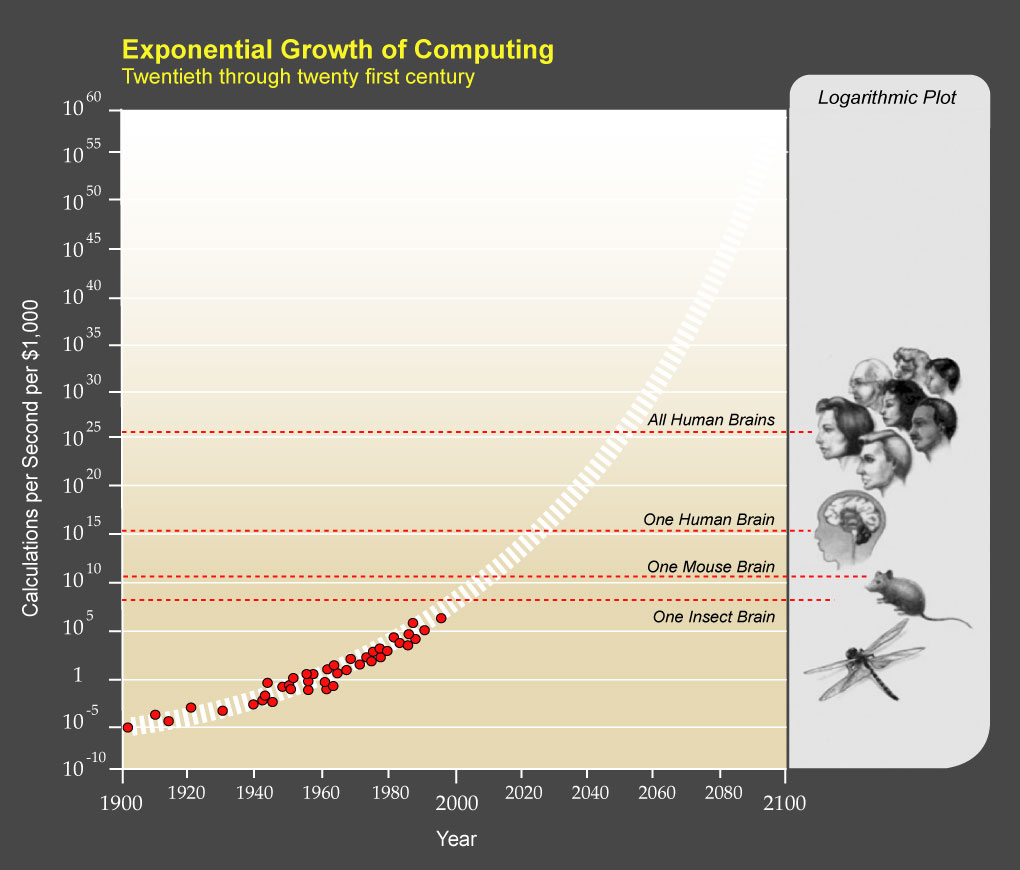
Then the globe'due south $i,000 computers are now beating the mouse brain and they're at nearly a thousandth of human level. This doesn't audio similar much until you call back that we were at almost a trillionth of man level in 1985, a billionth in 1995, and a millionth in 2005. Being at a thousandth in 2022 puts united states right on pace to go to an affordable computer by 2025 that rivals the power of the encephalon.
So on the hardware side, the raw power needed for AGI is technically bachelor now, in China, and we'll be ready for affordable, widespread AGI-caliber hardware inside x years. But raw computational power lone doesn't make a computer generally intelligent—the adjacent question is, how do we bring human-level intelligence to all that power?
Second Key to Creating AGI: Making It Smart
This is the disgusting part. The truth is, no 1 really knows how to make information technology smart—we're still debating how to make a reckoner man-level intelligent and capable of knowing what a canis familiaris and a weird-written B and a mediocre film is. But in that location are a bunch of far-fetched strategies out there and at some bespeak, one of them volition work. Hither are the three most mutual strategies I came across:
1) Plagiarize the brain.
This is similar scientists toiling over how that child who sits next to them in class is so smart and keeps doing then well on the tests, and fifty-fifty though they keep studying diligently, they can't do nearly likewise as that kid, so they finally determine "chiliad fuck it I'grand only gonna copy that kid'southward answers." It makes sense—we're stumped trying to build a super-complex computer, and there happens to exist a perfect prototype for one in each of our heads.
The science world is working hard on reverse engineering the encephalon to effigy out how development made such a rad thing—optimistic estimates say we tin do this by 2030. Once nosotros practise that, we'll know all the secrets of how the brain runs then powerfully and efficiently and we can depict inspiration from information technology and steal its innovations. One instance of computer compages that mimics the brain is the artificial neural network. It starts out as a network of transistor "neurons," continued to each other with inputs and outputs, and it knows nothing—like an infant brain. The way information technology "learns" is it tries to exercise a chore, say handwriting recognition, and at first, its neural firings and subsequent guesses at deciphering each letter will be completely random. But when it's told information technology got something right, the transistor connections in the firing pathways that happened to create that answer are strengthened; when it'south told it was incorrect, those pathways' connections are weakened. Later a lot of this trial and feedback, the network has, by itself, formed smart neural pathways and the motorcar has become optimized for the task. The encephalon learns a flake like this but in a more than sophisticated way, and as we continue to study the brain, nosotros're discovering ingenious new ways to take advantage of neural circuitry.
More extreme plagiarism involves a strategy called "whole brain emulation," where the goal is to slice a real encephalon into thin layers, scan each one, apply software to assemble an accurate reconstructed iii-D model, and and then implement the model on a powerful computer. Nosotros'd then have a computer officially capable of everything the brain is capable of—information technology would just need to learn and assemble information. If engineers go really skilful, they'd be able to emulate a real encephalon with such verbal accurateness that the brain's full personality and memory would be intact one time the brain architecture has been uploaded to a estimator. If the brain belonged to Jim right before he passed abroad, the computer would at present wake up as Jim (?), which would be a robust human-level AGI, and we could now piece of work on turning Jim into an unimaginably smart ASI, which he'd probably be really excited almost.
How far are we from achieving whole brain emulation? Well so far, we've not yet simply recently been able to emulate a 1mm-long flatworm brain, which consists of simply 302 total neurons. The human brain contains 100 billion. If that makes it seem like a hopeless project, remember the power of exponential progress—now that we've conquered the tiny worm brain, an ant might happen before too long, followed by a mouse, and suddenly this will seem much more plausible.
2) Attempt to brand development practice what it did before but for the states this time.
Then if we decide the smart kid'due south test is too hard to copy, we can try to copy the fashion he studies for the tests instead.
Here's something we know. Building a estimator as powerful as the brain is possible—our own encephalon's evolution is proof. And if the brain is just likewise complex for us to emulate, we could effort to emulate evolution instead. The fact is, even if we tin emulate a brain, that might exist like trying to build an plane by copying a bird'southward wing-flapping motions—often, machines are best designed using a fresh, machine-oriented arroyo, not past mimicking biology exactly.
So how tin we simulate evolution to build AGI? The method, called "genetic algorithms," would work something like this: there would be a performance-and-evaluation process that would happen again and again (the same style biological creatures "perform" by living life and are "evaluated" past whether they manage to reproduce or not). A grouping of computers would try to do tasks, and the most successful ones would exist bred with each other by having half of each of their programming merged together into a new calculator. The less successful ones would be eliminated. Over many, many iterations, this natural selection procedure would produce better and better computers. The challenge would be creating an automatic evaluation and breeding cycle so this evolution process could run on its own.
The downside of copying development is that evolution likes to take a billion years to practice things and we want to do this in a few decades.
But we have a lot of advantages over evolution. First, development has no foresight and works randomly—it produces more unhelpful mutations than helpful ones, but nosotros would control the process and so information technology would but exist driven past beneficial glitches and targeted tweaks. Secondly, evolution doesn't aim for annihilation, including intelligence—sometimes an environment might even select against higher intelligence (since information technology uses a lot of energy). We, on the other hand, could specifically direct this evolutionary process toward increasing intelligence. Third, to select for intelligence, evolution has to introduce in a bunch of other means to facilitate intelligence—like revamping the means cells produce energy—when we tin remove those extra burdens and utilise things like electricity. Information technology's no incertitude we'd be much, much faster than evolution—merely information technology'due south still not clear whether we'll be able to meliorate upon evolution enough to make this a feasible strategy.
3) Make this whole thing the computer's problem, not ours.
This is when scientists get desperate and try to plan the examination to accept itself. But it might exist the most promising method nosotros have.
The idea is that we'd build a figurer whose ii major skills would be doing research on AI and coding changes into itself—allowing it to not only learn but to amend its ain architecture. We'd teach computers to be computer scientists so they could bootstrap their own development. And that would be their main job—figuring out how to brand themselves smarter. More on this afterwards.
All of This Could Happen Presently
Rapid advancements in hardware and innovative experimentation with software are happening simultaneously, and AGI could pitter-patter upwardly on u.s.a. quickly and unexpectedly for two master reasons:
1) Exponential growth is intense and what seems like a snail's pace of advocacy tin quickly race upwards—this GIF illustrates this concept nicely:
2) When it comes to software, progress can seem irksome, but then one epiphany can instantly modify the rate of advancement (kind of like the way scientific discipline, during the time humans thought the universe was geocentric, was having difficulty calculating how the universe worked, but and so the discovery that it was heliocentric of a sudden made everything much easier). Or, when information technology comes to something like a calculator that improves itself, we might seem far abroad but actually be just 1 tweak of the system away from having it become 1,000 times more than effective and zooming upward to human-level intelligence.
The Route From AGI to ASI
At some signal, nosotros'll have achieved AGI—computers with human-level general intelligence. Just a agglomeration of people and computers living together in equality.
Oh really not at all.
The thing is, AGI with an identical level of intelligence and computational capacity as a man would still have significant advantages over humans. Similar:
Hardware:
- Speed. The brain's neurons max out at around 200 Hz, while today'southward microprocessors (which are much slower than they will be when we accomplish AGI) run at two GHz, or 10 1000000 times faster than our neurons. And the brain's internal communications, which can move at about 120 chiliad/s, are horribly outmatched by a computer's ability to communicate optically at the speed of light.
- Size and storage. The brain is locked into its size by the shape of our skulls, and it couldn't get much bigger anyway, or the 120 m/s internal communications would take besides long to get from one encephalon construction to another. Computers can expand to any physical size, assuasive far more hardware to be put to work, a much larger working memory (RAM), and a longterm memory (difficult drive storage) that has both far greater capacity and precision than our own.
- Reliability and durability. It'due south not only the memories of a computer that would be more precise. Computer transistors are more accurate than biological neurons, and they're less likely to deteriorate (and can be repaired or replaced if they practice). Human brains also get drawn hands, while computers can run nonstop, at peak operation, 24/7.
Software:
- Editability, upgradability, and a wider breadth of possibility. Unlike the human encephalon, computer software can receive updates and fixes and tin be easily experimented on. The upgrades could also bridge to areas where homo brains are weak. Homo vision software is superbly advanced, while its complex engineering capability is pretty low-grade. Computers could friction match the man on vision software merely could also become equally optimized in engineering and whatsoever other area.
- Collective capability. Humans trounce all other species at building a vast collective intelligence. Outset with the development of language and the forming of big, dense communities, advancing through the inventions of writing and printing, and now intensified through tools like the net, humanity'southward collective intelligence is one of the major reasons we've been able to get so far ahead of all other species. And computers volition exist way better at it than we are. A worldwide network of AI running a detail program could regularly sync with itself and so that anything any one estimator learned would be instantly uploaded to all other computers. The group could too have on one goal as a unit, because there wouldn't necessarily be dissenting opinions and motivations and self-involvement, like we have within the human population.10
AI, which will likely become to AGI by being programmed to self-improve, wouldn't see "homo-level intelligence" every bit some important milestone—it's only a relevant marker from our point of view—and wouldn't have any reason to "stop" at our level. And given the advantages over united states of america that even human intelligence-equivalent AGI would have, it'southward pretty obvious that it would only hit human intelligence for a brief instant before racing onwards to the realm of superior-to-human intelligence.
This may shock the shit out of united states when it happens. The reason is that from our perspective, A) while the intelligence of different kinds of animals varies, the main feature we're aware of virtually any animate being's intelligence is that information technology's far lower than ours, and B) we view the smartest humans equally WAY smarter than the dumbest humans. Kind of similar this:
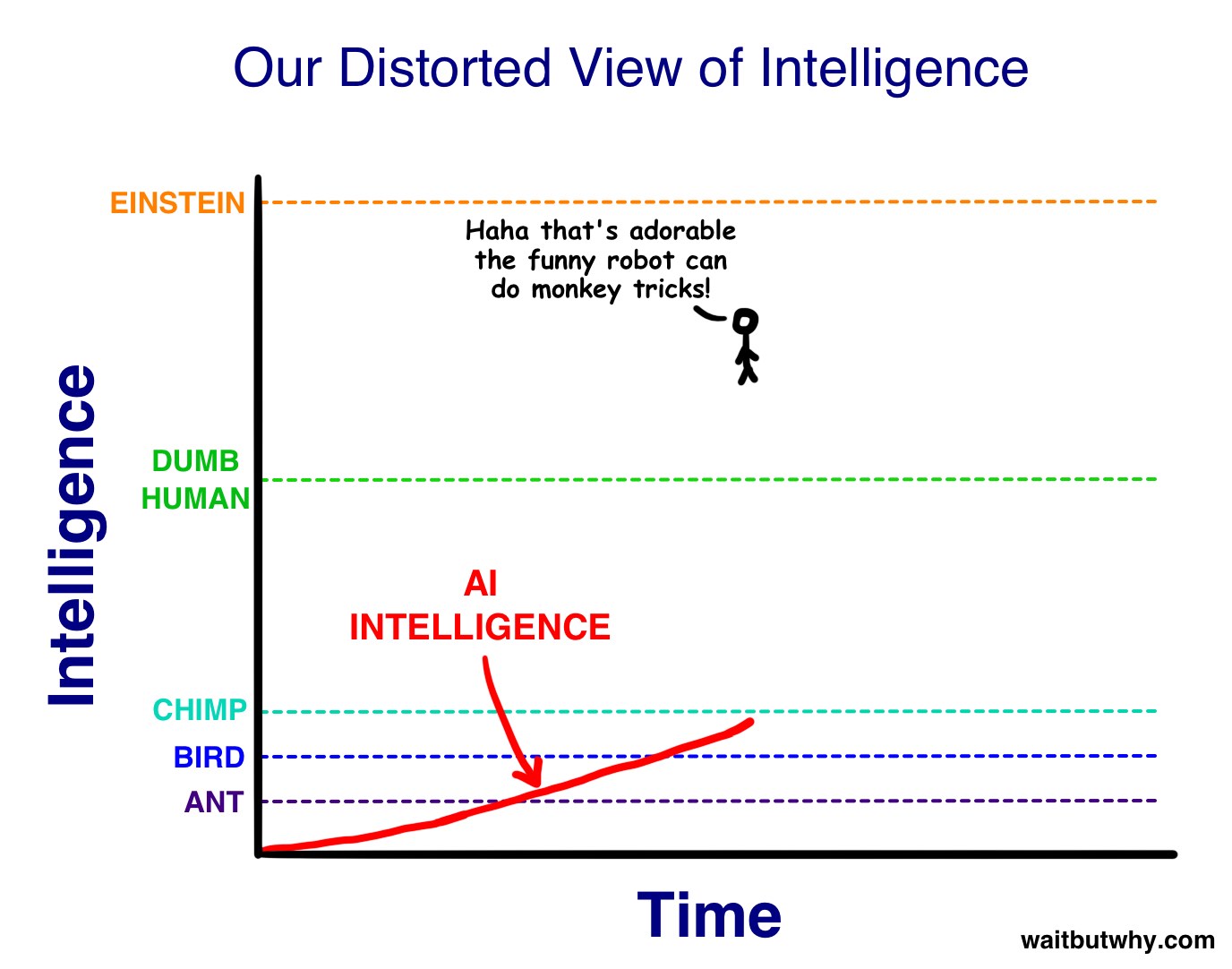
Then as AI zooms upwards in intelligence toward us, we'll encounter it equally merely becoming smarter, for an animal. Then, when it hits the everyman capacity of humanity—Nick Bostrom uses the term "the village idiot"—we'll exist like, "Oh wow, it's like a dumb human. Beautiful!" The only thing is, in the 1000 spectrum of intelligence, all humans, from the village idiot to Einstein, are within a very pocket-sized range—so just after hitting hamlet idiot level and being declared to exist AGI, it'll suddenly be smarter than Einstein and we won't know what hit the states:
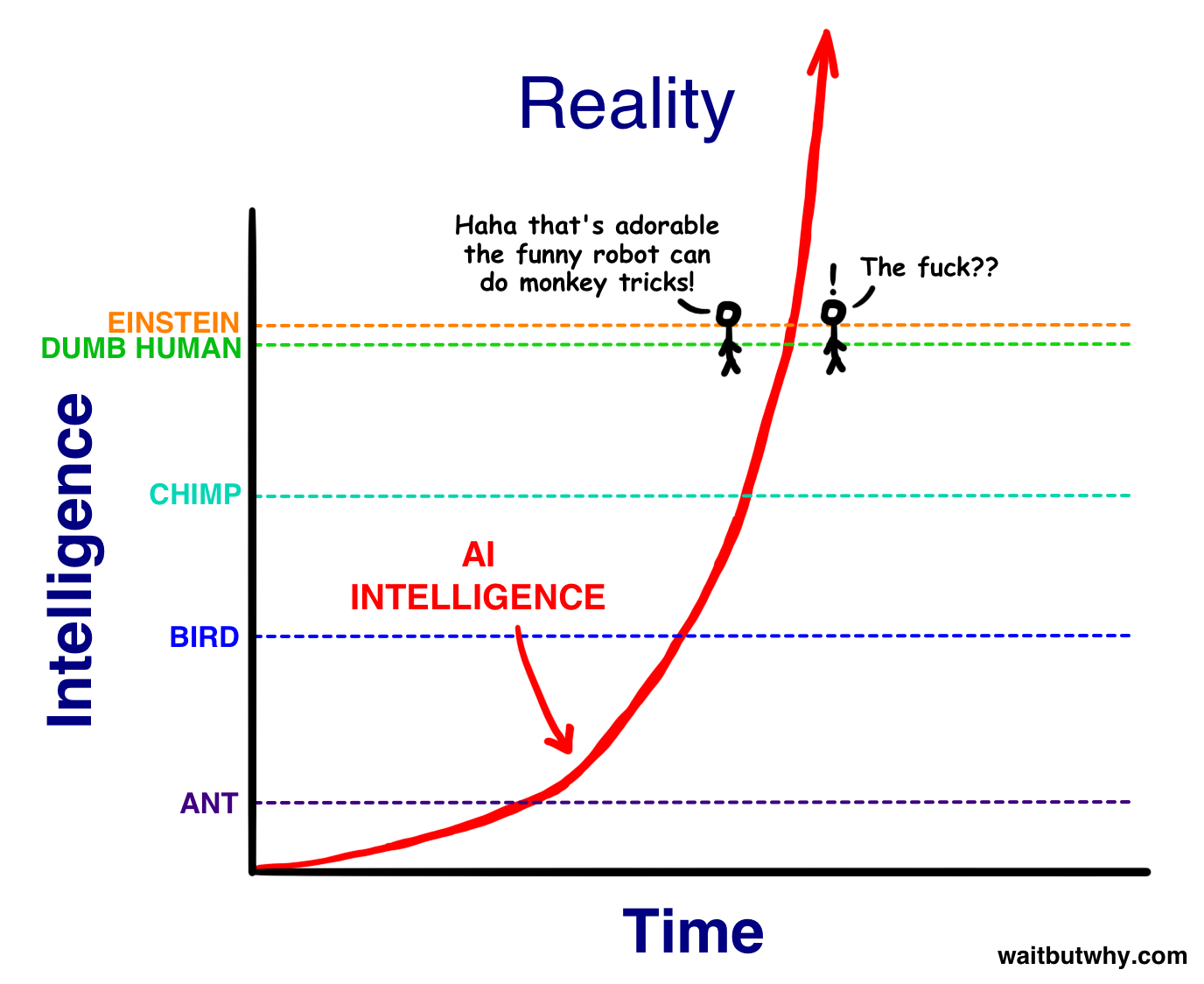
And what happens…after that?
An Intelligence Explosion
I hope you enjoyed normal time, considering this is when this topic gets unnormal and scary, and information technology's gonna stay that way from hither frontward. I desire to pause hither to remind you that every unmarried affair I'm going to say is real—real science and real forecasts of the time to come from a big array of the almost respected thinkers and scientists. Only keep remembering that.
Anyway, as I said above, almost of our current models for getting to AGI involve the AI getting there by self-improvement. And once it gets to AGI, even systems that formed and grew through methods that didn't involve self-improvement would now exist smart enough to brainstorm cocky-improving if they wanted to.iii
And here's where nosotros get to an intense concept: recursive self-improvement. It works like this—
An AI organization at a sure level—permit's say human village idiot—is programmed with the goal of improving its ain intelligence. Once it does, it'southward smarter—maybe at this point it's at Einstein'south level—and so now when information technology works to better its intelligence, with an Einstein-level intellect, it has an easier time and information technology can make bigger leaps. These leaps make information technology much smarter than whatever human, assuasive it to make fifty-fifty bigger leaps. Equally the leaps grow larger and happen more speedily, the AGI soars up in intelligence and soon reaches the superintelligent level of an ASI system. This is called an Intelligence Explosion,11 and it's the ultimate example of The Law of Accelerating Returns.
There is some fence about how soon AI will attain man-level general intelligence. The median year on a survey of hundreds of scientists about when they believed we'd be more likely than not to have reached AGI was 204012—that's only 25 years from now, which doesn't sound that huge until you consider that many of the thinkers in this field think information technology's probable that the progression from AGI to ASI happens very rapidly. Like—this could happen:
It takes decades for the starting time AI organisation to reach low-level full general intelligence, but information technology finally happens. A figurer is able to understand the world around it likewise as a human four-yr-old. Suddenly, within an hour of striking that milestone, the system pumps out the thousand theory of physics that unifies general relativity and quantum mechanics, something no man has been able to definitively practice. 90 minutes after that, the AI has become an ASI, 170,000 times more than intelligent than a human.
Superintelligence of that magnitude is non something we can remotely grasp, any more than a bumblebee tin wrap its head effectually Keynesian Economics. In our world, smart ways a 130 IQ and stupid means an 85 IQ—nosotros don't take a discussion for an IQ of 12,952.
What we practise know is that humans' utter dominance on this Earth suggests a clear rule: with intelligence comes power. Which means an ASI, when nosotros create it, will be the nearly powerful being in the history of life on Earth, and all living things, including humans, will be entirely at its whim—and this might happen in the side by side few decades.
If our meager brains were able to invent wifi, so something 100 or ane,000 or ane billion times smarter than we are should accept no trouble controlling the positioning of each and every atom in the world in whatever fashion it likes, at any time—everything nosotros consider magic, every power nosotros imagine a supreme God to have volition be as mundane an activity for the ASI equally flipping on a calorie-free switch is for u.s.. Creating the technology to reverse human aging, curing illness and hunger and fifty-fifty mortality, reprogramming the weather to protect the future of life on Earth—all suddenly possible. As well possible is the immediate cease of all life on Earth. As far as we're concerned, if an ASI comes to beingness, there is now an omnipotent God on Earth—and the earth-shaking question for u.s.a. is:
Will it exist a nice God?
That's the topic of Part 2 of this post.
___________
Sources at the lesser of Part two.
![]()
If you're into Wait But Why, sign upwardly for the Wait But Why email list and we'll transport you the new posts right when they come up out. That's the only matter we use the listing for—and since my posting schedule isn't exactly…regular…this is the all-time way to stay upwardly-to-date with WBW posts.
If you'd like to support Wait But Why, here's our Patreon.
Related Await Only Why Posts
The Fermi Paradox – Why don't we see any signs of alien life?
How (and Why) SpaceX Will Colonize Mars – A mail I got to work on with Elon Musk and one that reframed my mental motion picture of the futurity.
Or for something totally different and yet somehow related, Why Procrastinators Procrastinate
And here's Year 1 of Wait Just Why on an ebook.
Source: https://waitbutwhy.com/2015/01/artificial-intelligence-revolution-1.html
Posted by: schofieldcolooter.blogspot.com


0 Response to "What Does An Average Brake Light Repair Cost"
Post a Comment